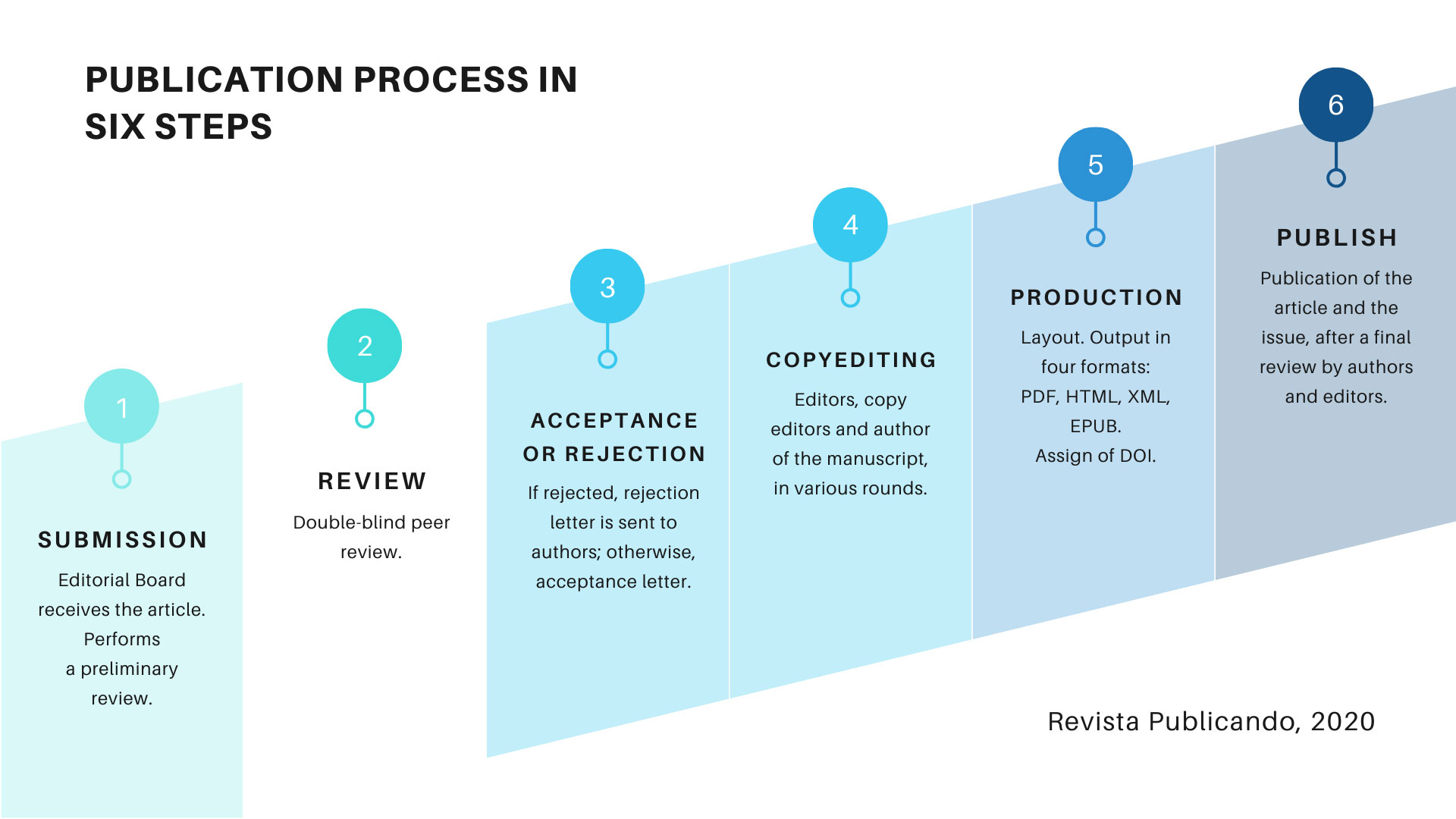Submission Preparation Checklist
As part of the submission process, authors are required to check off their submission's compliance with all of the following items, and submissions may be returned to authors that do not adhere to these guidelines.
- One author has been designated as the «corresponding author» with contact details: • Email address • ORCID • Institutional Affiliation • Biography (Optional. No more than 250 words)
- The text adheres to the stylistic and bibliographic requirements outlined in the «Author Guidelines» section.
- Manuscript has been 'spell checked' and 'grammar checked'.
- The manuscript includes the title in English; keywords in English (up to five); all tables and figures include titles, descriptions, and references; the figures have the appropriate resolution.
- The rest of the authors have included their ORCID, email, institutional affiliation (in case of not having one: «independent researcher»), and optionally a short biography of no more than 250 words.
- All references mentioned in the Reference List are cited in the text, and vice versa.
- Permission has been obtained for use of copyrighted material from other sources (including the Internet).
- The submission file is in OpenOffice, Microsoft Word, RTF, or WordPerfect format.
- The submission has not been previously published, nor has it been sent to another journal for consideration.
- You have reviewed the section of Articles Processing Charges (APC). By submitting the paper, you are accepting the Article Processing Charges and Waiving Policies of Revista Publicando.
- When possible, URL addresses for references are provided, as well as the DOI.

Introduction
Texts submitted must be the result of original and unpublished research. All submissions undergo an initial evaluation by the General Editor and the Editorial Board. In this first stage, it is determined whether the submissions comply with the formal aspects. It is also examined whether the objectives are in line with the topics promoted by the journal.
If approved, reviewers are assigned. Publicando will proceed if the article receives positive evaluations from the reviewers, even if they present some corrections.
After the review (which should not exceed five weeks) the author will be informed of the approval, rejection, or approval with modifications of the article.

Note: For more information, please see the sections about Review policies, Author fees, and our Ethical Statement.
General characteristics of the content
All submitted manuscripts must comply with the following characteristics of scientific research:
- Be original and unpublished. They should not have been published in any media or be in the process of publication.
- Address problems that respond to current and relevant needs in social sciences.
- To contribute to the framework of research ethics. Use clear, precise, and understandable language. Not to use, defend, support, or echo discriminatory, offensive, or banal content.
Failure to comply with any of these general rules implies the automatic rejection of the text.
Types of contributions
Our main objective is the publication of original material of academic quality. We accept research results or theoretical reflections in any of the following formats: research article, theoretical article, review article (literature review or systematic review), book review, essay, editorial and translations in social sciences.
a. Original research article
It introduces the actual results of completed research projects. The article structure should have the following sections: Introduction, Methods, Results, Discussion, Conclusions, References. Authors should use this structure or similar variants. Articles of this nature will have a minimum of 3000 words and a maximum of 10,000 words, including titles, abstracts, keywords, and references.
b. Theoretical article
A document that presents completed research results from an analytical, interpretative, or critical perspective on a specific topic, using original sources. The internal logic of the manuscript is appreciated, as well as the thoughtful power of the ideas presented. It constitutes a novel and conceptual discussion on aspects that are necessary and essential for society. This contribution should have between 3000 and 10,000 words, including titles, abstracts, keywords, and references.
c. Review article (literature review or systematic review)
Written to bring together and summarize the results/conclusions from multiple original research articles/studies. This type of paper will not usually have a methodology section, and they generally have very extensive bibliographies. This contribution should have between 3000 and 10,000 words, including titles, abstracts, keywords, and references.
d. Book review
While written by scholars, book reviews in scholarly journals are meant to provide a summary of a newly published book. Book reviews can lead to the discovery of new sources to investigate. Proposals may come from the author himself or the publisher. This contribution should have up to 2000 words. The document should include the details of the reviewed edition.
e. Essay
It does not have a pre-established scheme since it depends on the author's rationality. However, the text must be characterized by coherence and internal cohesion, based on an investigative-reflective discourse considering the topic's bibliographic background. Essays must have between 1800 and 5000 words. Although this type of contribution style is open and allows greater stylistic freedom, the author must respect a basic methodology and structure. The text should at least clearly state its objective and conclusion.
f. Other types of contributions
Letters to the editor, critical commentaries, translations, or other scientific communication forms will be evaluated on a case-by-case basis with the Editorial Board.
Submission Package
When submitting your scientific contribution, it must be sent together with:
- Original manuscript adequately anonymized. You must delete all traces of the authors in notes, references, and general information of the document. Besides, it must follow our style and content guidelines.
- Cover letter presenting the contribution and its importance for the international scientific community. This letter should contain all authors' information (name and last name, institutional affiliation, ORCID, email, and optionally a short biography of the authors of up to 250 words).
- Declaration of Authorship, which can be downloaded from this page, completed, and signed by all authors.
Likewise, the responsible or primary author must correctly complete the submission form in our online journal. It is his/her responsibility to provide correct and reliable data of the authors.
Manuscripts must be submitted only and exclusively through our online journal, in which all authors must register beforehand. In exceptional cases, documents sent by email will be accepted. When submitting in this way, the author(s) must also send the Declaration of Authorship and the Cover Letter with the author's personal and professional data (s).
Manuscript Format and Style

- The originals must be in .doc or compatible format. Originals in .pdf format will not be accepted.
- We accept contributions in Spanish and English.
- Texts should use Times New Roman (or similar standard font), 12 pt., 1.5 line spacing, justified to the left.
- The size of the page should be "Letter" / 21.59 cm x 27.94 cm (8 1/2" x 11").
- Page margins should be set at 2.54 cm (1 inch) on each page's side (top, bottom, left, right).
- Titles should be no longer than 100 characters with space, and should be descriptive, correctly expressing the research's problematic essence.
- Abstracts should not exceed 250 words. They should generally answer the following questions: justification of the subject, objectives, methods, results, and conclusions.
- Manuscripts should have up to five keywords.
- In the text, avoid excessive and indiscriminate use of CAPITAL LETTERS, words in italics or boldface, except when logically appropriate.
- Notes should be placed at the foot of the page and not at the end.
- Check the data, sources, tables, or diagrams if you have used any of these.
- Figures and tables used should be of acceptable quality and legible.
- For citations in the text and list of references, Revista Publicando takes as a guide the 7th Edition of the Publication Manual of the APA. Bibliographical references cited in the text should appear in the reference list at the end of the paper. Avoid quotations from unreliable sources, especially in the case of the Internet.
- In all cases where it can be provided, authors should place the corresponding doi in the reference. The doi should always be shown as a complete URL link, as follows: https://doi.org/10.xxxx/xxxxx. It should not be preceded by "doi:" or "DOI:"
- If hyperlinks are used in the references for URLs, they should be reduced. For hyperlink shortening, you can use the free tool Bitly.
- For any questions about topics to be published, style or format, please contact us at the following email address.
- Articles selected for publication will not receive any financial compensation.
How to display a DOI - Crossref
Revista Publicando is a Crossref member; it is our responsibility to indicate how a DOI should be displayed. In doing so, please follow these guidelines. Crossref DOIs should:
- always be displayed as a full URL link in the form https://doi.org/10.xxxx/xxxxx
- not be preceded by doi: or DOI:
- not use dx in the domain name part of DOI links
- and we recommend HTTPS (rather than HTTP).
The structure of a DOI
A DOI (digital object identifier) is a persistent identifier attached to content (such as an article, chapter). It's displayed as a link, and looks like this:
As you can see, it has several parts:
- https://doi.org/ = the DOI resolver: makes the DOI a URL (actionable)
- 5555 = prefix: assigned by Crossref
- YFRU1371 = suffix: decided and assigned by the member, should be opaque.

Crossref DOIs in reference lists and bibliographies
Linking references in journal articles using Crossref DOIs is a condition of membership. This means including the DOI for each item in your reference list. We strongly encourage members to link references for other content types too. Because there are space constraints even in online references lists, Crossref DOIs can be displayed in several ways, depending on the publisher's preference and publication style. We recommend the following options:
- use the Crossref DOI URL as the permanent link. Example: Soleimani N, Mohabati Mobarez A, Farhangi B. Cloning, expression and purification flagellar sheath adhesion of Helicobacter pylori in Escherichia coli host as a vaccination target. Clin Exp Vaccine Res. 2016 Jan;5(1):19-25. https://doi.org/10.7774/cevr.2016.5.1.19
- display the text Crossref with a permanent DOI link behind the text. Example: Galli, S.J., and M. Tsai. 2010. Mast cells in allergy and infection: versatile effector and regulatory cells in innate and adaptive immunity. Eur. J. Immunol. 40:1843–1851. Crossref.
Last update
February 11, 2021
